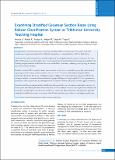Please use this identifier to cite or link to this item:
https://hdl.handle.net/20.500.14356/1870| Title: | Examining Stratified Cesarean Section Rates Using Robson Classification System at Tribhuvan University Teaching Hospital |
| Authors: | Amatya, A Paudel, R Poudyal, A Wagle, R R Singh, M Thapa, S |
| Citation: | AmatyaA., PaudelR., PoudyalA., WagleR. R., SinghM., & ThapaS. (2014). Examining Stratified Cesarean Section Rates Using Robson Classification System at Tribhuvan University Teaching Hospital. Journal of Nepal Health Research Council. https://doi.org/10.33314/jnhrc.v0i0.400 |
| Issue Date: | 2013 |
| Publisher: | Nepal Health Research Council |
| Article Type: | Original Article |
| Keywords: | Cesarean Section Quality improvement Stratification |
| Series/Report no.: | May-Aug, 2013;400 |
| Abstract: | Abstract Background: Caesarean section rates have been increasing worldwide over the past few decades, with most countries and regions exceeding the World Health Organization recommended rate of 15% of all deliveries. Methods: This study was carried out with the objective of reviewing the rates of cesarean sections over five years (2005-2010) and to assess the stratified rates of cesarean sections for audit of intrapartum management in University Teaching Hospital, Institute of Medicine. Data was stratified into 10 mutually exclusive groups, by using the method presented by Michael Robson. Results: A total of 5907 women had under gone caeserean section over a period of five years. The results showed a growing trend of cesarean section rate from 16.6% to 25.4%. The results of this analysis using the Robson classification has               shown that       group   1(Nulliparous,   single cephalic ≥ 37 weeks gestation in spontaneous labour) has the largest number of cesarean      deliveries followed by group 3(Multiparous, single cephalic ≥37 weeks  gestation in spontaneous labor, no previous CS), although Robson classification showed that group 5 was the biggest contributor. Conclusions: The growing and uniform distribution (throughout the year) of cesarean section has been observed for five years. This analysis provides evidence-based data so we can analyze where to aim our preventive measures and focus efforts in reducing the rate of CS. We would like to suggest that all hospitals and health authorities apply this standardized classification system as to monitor their CS rates and find ways to reduce it, and improve quality care. Keywords: Cesarean Section; quality improvement; stratification. |
| Description: | Original Article |
| URI: | http://103.69.126.140:8080/handle/20.500.14356/1870 |
| ISSN: | Print ISSN: 1727-5482; Online ISSN: 1999-6217 |
| Appears in Collections: | Vol. 11 No. 3 Issue 25 Sep - Dec, 2013 |
Files in This Item:
| File | Description | Size | Format | |
|---|---|---|---|---|
| 400-Article Text-495-2-10-20180731.pdf | Fulltext Download | 177.92 kB | Adobe PDF |  View/Open |
Items in DSpace are protected by copyright, with all rights reserved, unless otherwise indicated.
